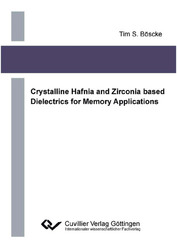| Departments | |
|---|---|
| Book Series (96) |
1378
|
| Nachhaltigkeit |
3
|
| Gesundheitswesen |
1
|
| Humanities |
2365
|
| Natural Sciences |
5406
|
| Mathematics | 229 |
| Informatics | 319 |
| Physics | 980 |
| Chemistry | 1363 |
| Geosciences | 131 |
| Human medicine | 243 |
| Stomatology | 10 |
| Veterinary medicine | 108 |
| Pharmacy | 147 |
| Biology | 835 |
| Biochemistry, molecular biology, gene technology | 121 |
| Biophysics | 25 |
| Domestic and nutritional science | 45 |
| Agricultural science | 1004 |
| Forest science | 201 |
| Horticultural science | 20 |
| Environmental research, ecology and landscape conservation | 148 |
| Engineering |
1793
|
| Common |
98
|
|
Leitlinien Unfallchirurgie
5. Auflage bestellen |
|
Advanced Search
Crystalline Hafnia and Zirconia based Dielectrics for Memory Applications (English shop)
Tim S. Böscke (Author)Preview
Table of Contents, Datei (29 KB)
Extract, Datei (250 KB)
This work investigates the crystallography and dielectric properties of Zirconium- and Hafnium-oxide based nano-scale thin film insulators for memory.
Hafnium- and Zirconium-oxide are industry leading candidates for high-k dielectrics. Most application research has focused on the application of amorphous high-k due to formation of defects associated with the crystalline phase. However the application of crystalline dielectrics offers two advantages: Potentially high thermal stability, since no measures have to be taken to avoid crystallization, and the ability to manipulate crystalline phase composition to maximize dielectric constants.
Pure ZrO2 crystallized at a lower temperature than HfO2 and always formed a metastable t’ higher-k phase. ZrO2 crystallized already during deposition, leading to leakage current degradation. It was shown that this problem could be solved by SiO2 addition to raise the crystallization temperature, allowing fabrication of low leakage, low effective oxide thickness (EOT) metal-insulator-metal (MIM) capacitors suitable for stack based DRAM down to the 4X nm node.
HfO2, in contrast, formed a mixture of monoclinic and tetragonal phase which led to the formation of mechanical defects (microcracks). Addition of SiO2 allowed manipulating the phase composition of HfO2. When up to 7 mol% SiO2 was added, increased stabilization of the metastable t’ phase with a dielectric constant of 34-36 was observed. It could be shown that the stabilization is due to a combination of a surface energy effect and solved SiO2 in the HfO2 lattice. Above 11 mol% SiO2 segregated from HfO2 and a tetragonal phase with higher c/a splitting and lower dielectric constant was stabilized instead.
It was discovered that the behavior of HfSiO was fundamentally altered if it was crystallized under mechanical confinement in presence of a top electrode. Besides a significant increase in dielectric constant, the material exhibited ferroelectric and antiferroelectric polarization hysteresis, a characteristic not previously reported for HfO2 or ZrO2. This behavior originated from the formation of a new orthorhombic crystal phase.
Utilizing the increased permittivity of the antiferroelectic phase, it was possible to demonstrate low EOT, highly temperature stable, MIM capacitors with potential application in sub 50 nm deep trench-DRAM generations.
Novel ferroelectric HfSiO was used to fabricate ferroelectric field effect transistors which allowed long term nonvolatile data storage. The electrical characteristics of the devices meet or exceed that of the best published literature results. Full compatibility to silicon semiconductor technology with a gate stack thickness down to 5 nm was demonstrated for the first time, suggesting that HfSiO based FEFETs can potentially be scaled to below the 30 nm node. This goal could not be achieved with previously known materials.
| ISBN-13 (Printausgabe) | 3869553464 |
| ISBN-13 (Hard Copy) | 9783869553467 |
| ISBN-13 (eBook) | 9783736933460 |
| Language | English |
| Page Number | 180 |
| Edition | 1 Aufl. |
| Volume | 0 |
| Publication Place | Göttingen |
| Place of Dissertation | Hamburg-Harburg |
| Publication Date | 2010-05-31 |
| General Categorization | Dissertation |
| Departments |
Physics
Electrical engineering |








